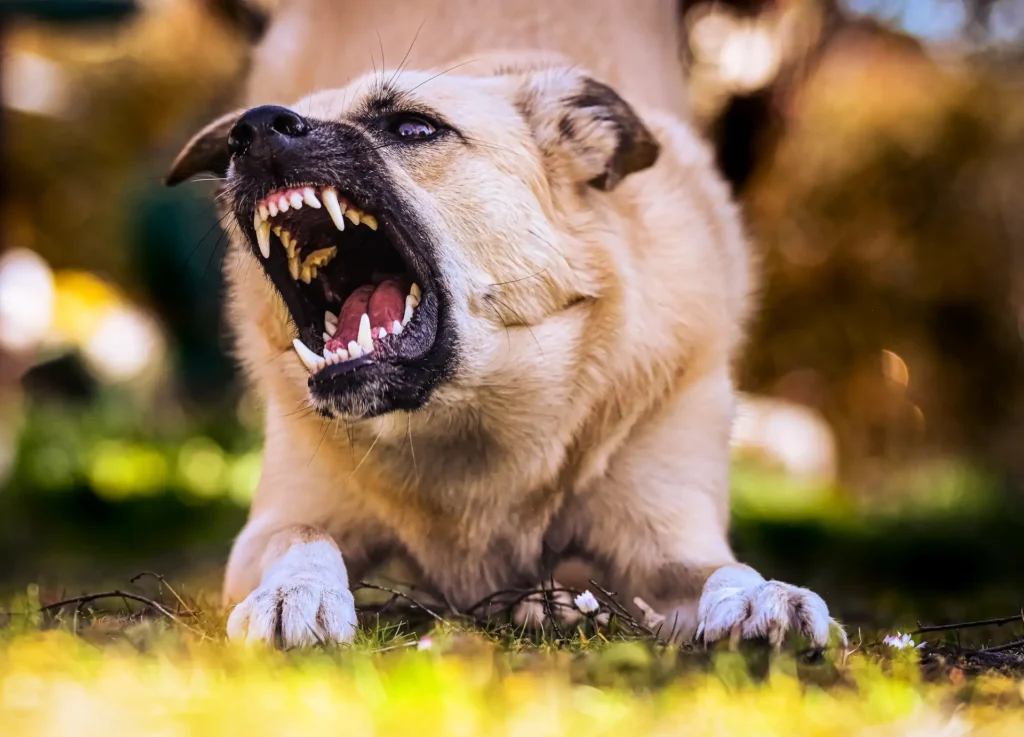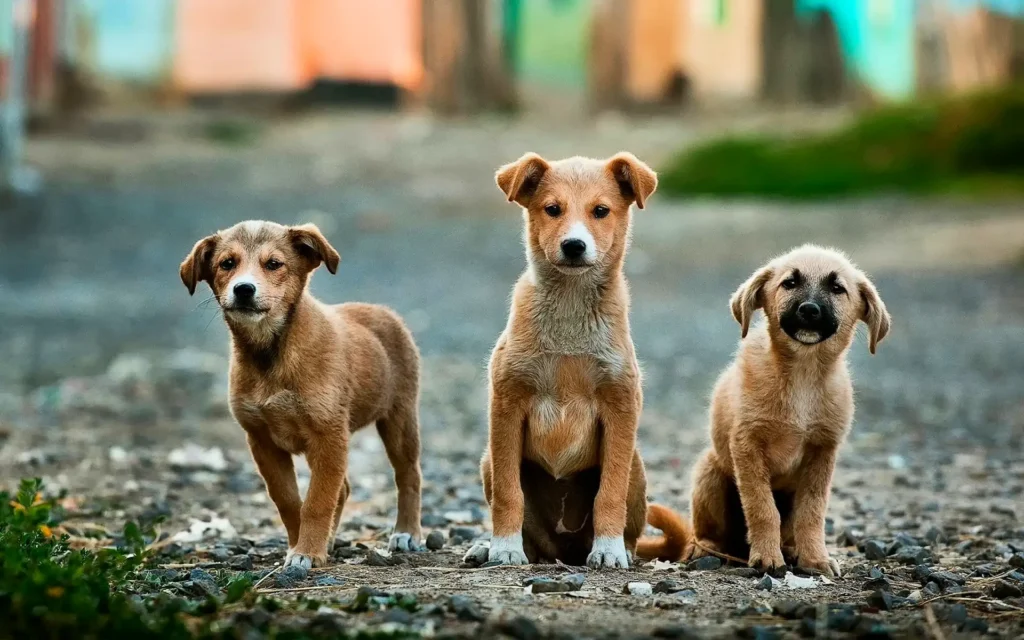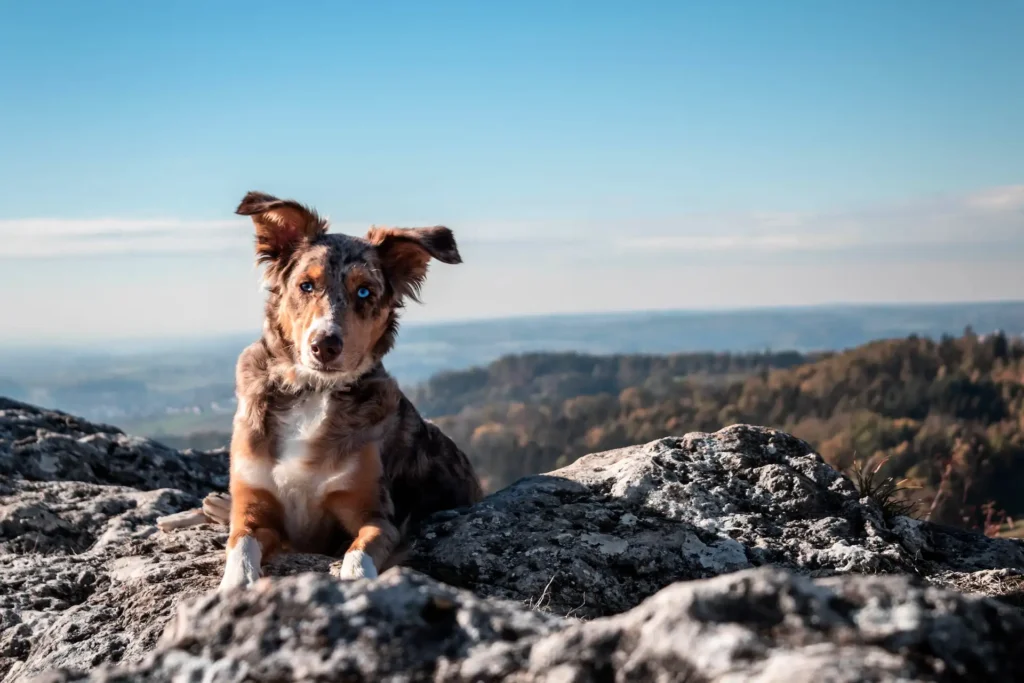Protect Yourself from Aggressive Dogs on hikes (17 tips)
This post may contain affiliate links. This means that we may receive a small commission from purchases through those links. Read more in our affiliate disclosure.
On my hikes throughout Taiwan, I often come across incredibly aggressive dogs, and have on more than one occasion almost been bitten. Here’s what I’ve learned on how to avoid dog bites and stay safe while hiking.
If a dog is fearful or barking at you defending their territorry, you can often calm it down by ignoring it, avoiding eye contact, and calmly walking away. This reassures the dog that you are not a threat. Don’t run, scream or turn your back. If a dog approaches you aggressively despite your deescalation attempts, make yourself tall and big and speak firmly and loudly. Most dogs can be scared away by picking up a rock (or pretending to) – just don’t actually attack.

- Introduction
- Types of aggressive dogs and how to react to them
- How to avoid provocating dogs
- 1. Give the Dog Space
- 2. Don’t Look the Dog in the Eye
- 3. Don’t Run or Turn Your Back
- 4. Don’t Show Fear
- 5. Don’t Smile
- 6. Speak Calmly and Softly
- 7. Carry/Collapse Your Hiking Poles
- 8. Don’t Kick or Hit the Dog
- How to react to an Aggressive Dog That Won’t Calm Down
- 9. Be Loud
- 10. Make Yourself Big
- 11. Pick Up a Rock or Stick (Or Pretend To)
- 12. Use Your Gear as a Shield
- 13. When on the Ground
- What to Do When Bitten
- 14. Wash the wound with Soap & water
- 15. Check Your Tetanus Vaccination Status
- 16. Find Out Dog’s Rabies Vaccination Status
- 17. Report the Bite
- Questionable Strategies
- Conclusion
Types of aggressive dogs and how to react to them
Depending on their life situations, dogs have various reasons for becoming aggressive; and the best course of action changes accordingly. In my experience, there are three main categories of dogs you might encounter on your hikes:
Fully stray dogs

Usually, stray dogs are fairly peaceful. They might get aggressive when they are afraid or hungry, for example when a mother is protecting her puppies. Typically, you can pacify them by using a soft, calming voice, not giving them much attention, and moving away in a calm way – see the tips below on how to avoid aggravating dogs.
Pet dogs
Ideally, pet dogs would be kept under control by their owners, but sadly, that’s not always the case. An upset or aggressive pet dog typically intends to protect their owner. For this reason, it helps to greet the owner in a friendly way – this will inform the dog that you are no threat.
Guard dogs
A guard dog’s job is to keep intruders away – so if one is barking at you, your best bet is to let it do its job, don’t threaten it, and calmly move away from whatever it is protecting. As they say, barking dogs don’t bite – most of the time, at least. A bark is a warning, and a message to the rest of the pack. (I’ve observed stray puppies in southern Italy barking to call their mum, so it seems that sometimes barks are calls for backup from the pack leader.) In these cases, if you heed the warning, and avoid acting like a threat, you’ll be fine.
The story changes if the dog snarls or growls at you, or just straight-out comes running, ready to bite, without a warning. I often encounter such behaviour in guard dogs who have been mistreated. On farms in Taiwan, you will often find dogs who are permanently chained to a spot, or just freely running around charging at any hiker or cyclist having the misfortune of passing by. Those are FIERCE. They must have suffered quite the psychological damage, and I feel sorry for them – but I don’t want their teeth anywhere near me. The section on how to react to dogs who won’t calm down lists tips for avoiding such fate.

How to avoid provocating dogs
1. Give the Dog Space
It is best to avoid direct interaction with stray or guard dogs. If you spot a dog at a distance, consider taking a detour, even if it means a slightly longer route, so as to not intrude upon the dog’s perceived territory.
However, there are times when a detour isn’t possible, or you didn’t notice the dog until it starts barking at you. In such situations, carefully back away from the dog. Sudden movements can be perceived as a threat. So, the best strategy is to move slowly, keeping your movements deliberate and calm, never turning your back. This ensures you maintain a visual on the dog’s behavior while simultaneously signaling that you’re not a threat.
2. Don’t Look the Dog in the Eye
In the canine world, direct eye contact is often interpreted as a challenge or a display of dominance. When you encounter an aggressive or unknown dog on a hike, don’t look them directly in the eye. This helps in not escalating the situation. Instead, keep the dog in your peripheral vision to stay aware of its movements without directly confronting it.
3. Don’t Run or Turn Your Back
A natural instinct when faced with a potentially aggressive dog might be to run. However, this is a race you can’t win. Running can trigger a dog’s chase instinct, leading to a more dangerous situation. Similarly, turning your back on the dog can be perceived as an opportunity for an attack. The best course of action is to remain still or move away slowly, showing the dog that you are neither a threat nor prey.
4. Don’t Show Fear
Dogs are remarkably adept at picking up on human emotions, including fear. Showing fear can sometimes provoke a dog, as they might interpret it as weakness or uncertainty. While it’s easier said than done, try to remain calm and composed. This can have a calming effect on the dog as well.
5. Don’t Smile
This might sound odd, but in the context of dog-human interactions, it’s quite pertinent. When we smile, we expose our teeth, which in the animal kingdom, is often a sign of aggression or challenge. So, while you might be inclined to smile in an attempt to appear friendly, it’s best to keep a neutral facial expression.
6. Speak Calmly and Softly
If you need to communicate with the dog (perhaps it’s blocking your path), do so in a calm and soft voice. Loud or aggressive tones can exacerbate the situation. Speaking calmly can sometimes reassure a dog that you’re not a threat.
7. Carry/Collapse Your Hiking Poles
Hiking poles are great tools for stability and support on trails, but in the presence of an aggressive dog, they can be perceived as weapons. If you’re carrying poles, it’s advisable to collapse them and hold them close to your body. Avoid swinging them around, as this might be perceived as a threatening gesture.
8. Don’t Kick or Hit the Dog
Physical aggression towards the dog is a definite no-go. Kicking or hitting not only escalates the situation but could also lead to a more aggressive response from the dog. The objective is to de-escalate and avoid conflict.
How to react to an Aggressive Dog That Won’t Calm Down

But what if all your attempts at deescalation fail – or if the dog comes chasing towards you, growling and baring its teeth? Then it’s time to be the top dog – make it clear that you have the authority here, will defend yourself, and shall not be chomped on.
9. Be Loud
Dogs have delicate ears, and can be intimidated by being firm and loud.
Use Loud, Firm Commands
Another tactic is to use your voice as a tool. Loud, firm commands such as “No!” or “Stay!” can sometimes assert your dominance and control over the situation. Dogs, even those not well-trained, often understand basic commands. The key here is the tone and confidence in your voice, more than what language you speak.
Blow a Whistle
The sharp, piercing sound of a whistle is unpleasant to the dog, causing it to reconsider its approach. This method works as it creates an unexpected noise that most dogs aren’t accustomed to, turning their aggression into confusion, and ultimately the decision to retreat and avoid the noise. You should be carrying an emergency whistle anyway, so if you expect to encounter aggressive dogs on your hikes, you can just attach it in an easy to reach spot on your backpack straps. (Some backpack buckles even have built-in whistles!)
Carry a Dog Chaser
For avid hikers who frequently encounter dogs, carrying a dog chaser device might be worth considering. These devices emit a loud high-frequency sound that’s very unpleasant to dogs but typically inaudible to humans. The ultrasonic noise reliably makes dogs back away and escape. It’s a non-invasive way to deter an aggressive dog and can provide a sense of security on your hikes.
10. Make Yourself Big
Making yourself appear larger than you are can be an effective deterrent. Dogs, especially those that are aggressive, tend to target what they perceive as smaller or weaker. By holding up your arms or spreading your jacket, you increase your apparent size. If you have hiking sticks, you can hold them up to enhance this effect.
11. Pick Up a Rock or Stick (Or Pretend To)
This tactic can be particularly effective with dogs that have unfortunately been mistreated. The action of picking up a rock or stick, or even the motion of pretending to do so, makes the dog afraid of being targeted. It’s important to note that this is not about attacking the dog with the object, but rather about creating a psychological barrier. The intention is to signal that you are not defenseless.
This method works pretty reliably on the exceptionally aggressive Taiwanese farm dogs, keeping them at a distance until I manage to leave their area.
12. Use Your Gear as a Shield
Your hiking gear can serve as a makeshift shield in a pinch. If an aggressive dog is advancing, putting your backpack or hiking pole between you and the dog can create a barrier. The pole can be particularly effective if pointed towards the dog, as it extends your reach and keeps the dog at a distance, giving it no chance to attack. Again, the goal is not to provoke but to create a safe boundary – just use the stick to point, not to hit.
13. When on the Ground
In the unfortunate event that you’re knocked down, the priority shifts to protecting your vital areas. Curling up into a ball with your hands over your head and neck area is a defensive posture. Make fists to protect your fingers. This position minimizes the amount of exposed skin and protects your face, neck, and abdomen, which are particularly vulnerable areas. Stay still and play dead until the dog loses interest in you.
What to Do When Bitten
14. Wash the wound with Soap & water
Dog mouths are filthy. To avoid an infection, your first step should be to wash out the wound; and seek medical attention if any swelling or discoloration develops.
15. Check Your Tetanus Vaccination Status
If you’ve been bitten by a dog (or any animal, for that matter), make sure your tetanus vaccination is up to date. Tetanus is a serious bacterial infection that can occur from dog bites due to the bacteria present in their saliva. The bacteria can enter your body through the wound. If it’s been more than 10 years since your last tetanus shot, or if you’re unsure of your vaccination history, go get a tetanus booster promptly.
16. Find Out Dog’s Rabies Vaccination Status
Rabies is another critical concern when dealing with dog bites. This viral disease is fatal if not treated promptly and can be transmitted through the saliva of an infected animal. After a bite, try to ascertain the rabies vaccination status of the dog. If the dog is a stray or its vaccination status is unknown, you must seek medical attention immediately for a rabies assessment and possible post-exposure prophylaxis. Rabies is preventable through vaccination, but once symptoms appear, it is almost always fatal.
17. Report the Bite
Reporting the dog bite is important for several reasons. It helps in tracking and managing potential rabies cases and also assists in the prevention of future incidents. Contact local animal control or public health departments to report the incident. They can take necessary steps, such as quarantining the dog to monitor for rabies. Reporting also helps in legal and medical documentation, which can be crucial if the bite leads to severe injuries or complications.
Questionable Strategies
While exploring various strategies to deal with aggressive dogs, I’ve come across some recommendations that are debatable in their effectiveness, especially when dealing with dangerous dogs in rural or hiking settings.
Some people suggest carrying dog treats as a way to appease an aggressive dog. While this might work with minorly aggressive urban dogs, it seems less likely to be effective with more unpredictable and possibly feral dogs encountered on hikes. And even if it works, do you really want to train an aggressive dog to approach hikers for food?
Another strategy proposed is carrying a water spray bottle to deter aggressive dogs. I find this one questionable since it requires the dog to come quite close in order to be able to hit with the water spray – and if it doesn’t work (or you aim wrong), it might already be too late to try something else. I’d rather have a stick between me and an angry dog than a spray bottle.
Opinions differ on the use of pepper spray – some say that dogs won’t even react to it, others claim it is effective. I have not been able to find reports of anyone trying this method being applied successfully by hikers. Bear spray is more damaging to dogs than pepper spray, and thus probably should be avoided. Personally, I don’t want to be carrying two different sprays, when there are other effective methods (most of which don’t require much extra weight to carry).

Conclusion
Equipped with these strategies, I hope that you will have safe hikes even in areas with dangerous dogs. Also, check out our guides on how to stay safe when faced with bears, cougars and stingy insects!




